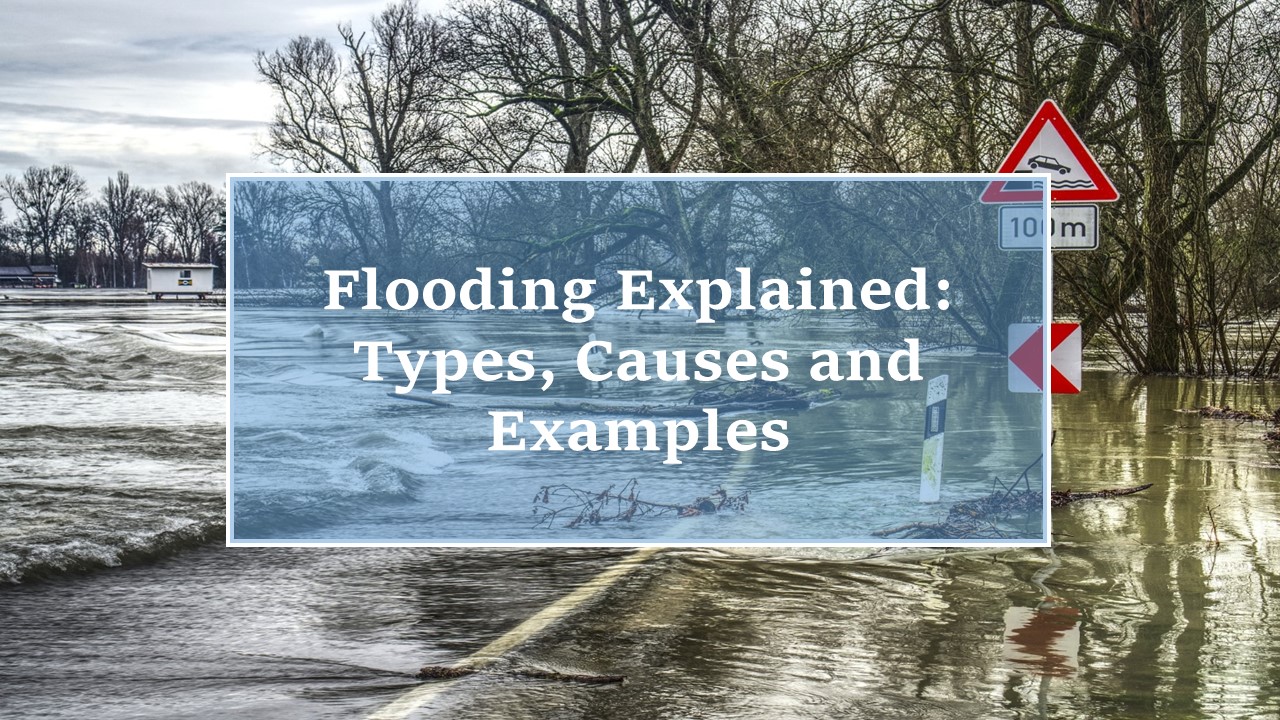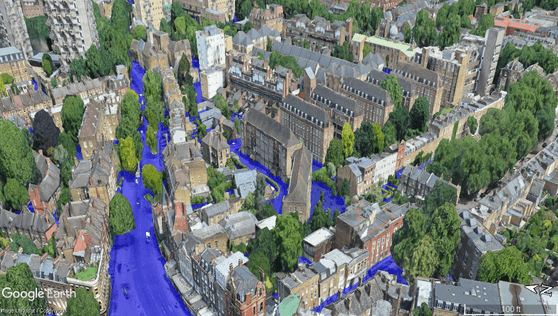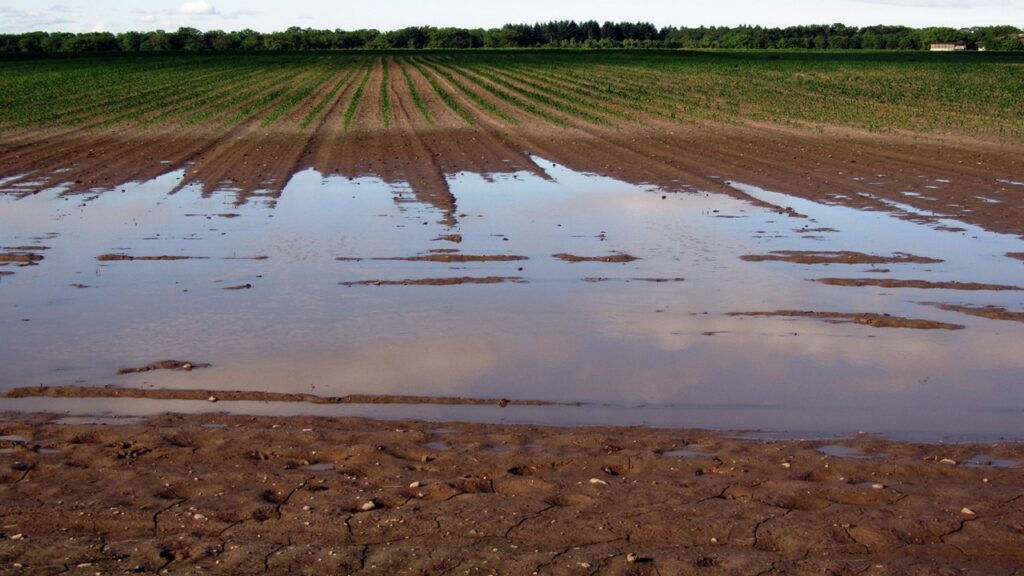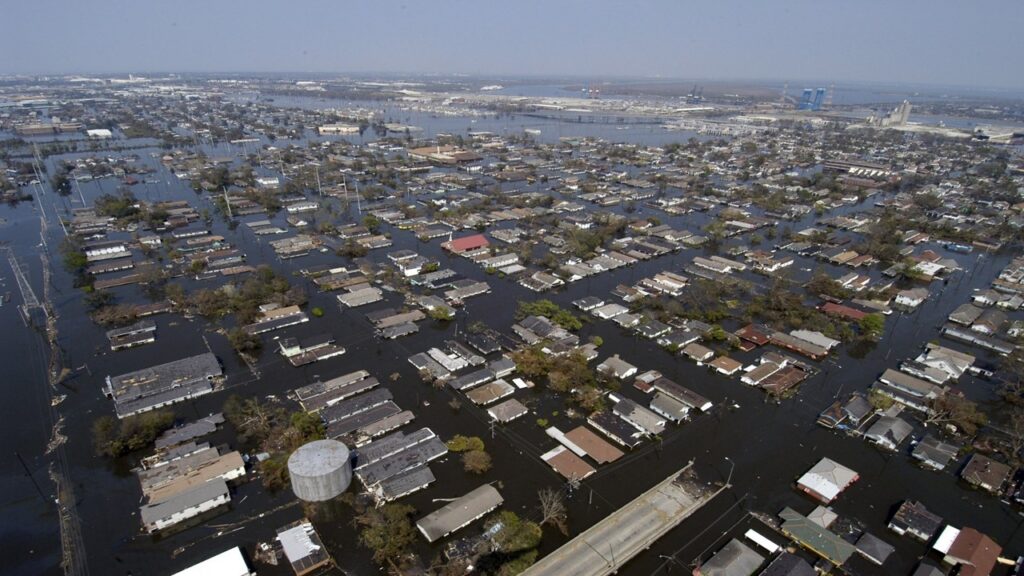Flooding Explained: Types, Causes and Examples

Flooding is the most common natural hazard that occurs in the world. Researchers estimate that sediments and soils from floods cover some 72% of the surface of the Earth. Perhaps the Yellow River in China has caused the worst floods in history. According to records, it has flooded more than 1500 times, killing over 900,000 people in one catastrophic event in 1887. Today, however, flooding events are becoming more frequent due to climate change and land-use changes.
What is flooding?
Flooding is the overflow of an unusually large amount of water onto land that is usually dry. A flood is thus the accumulation of water in places where it does not normally occur. The surplus water can come from the sea, rivers, reservoirs, rainfall, lakes and canals.
Floods can be as deep as a few centimetres or even reach rooftops! Also, they can occur within minutes or over long periods of time. As an example, in 2019, the Mississippi River remained above flood stage for over 235 days!

Characteristics of floods
Basically, we characterize floods according to their:
- Frequency – the rate at which they occur over a specific time period or,
- Return period – the average time between the flood events (recurrence).
Additionally, we can also define them at various points along their course using different variables such as:
- Depth
- Duration
- Velocity
- Extent
- Load and
- Lag time
Types of floods
Various types of floods exist based criteria such as geography, speed and source.
In general, we classify floods into 5 main types: river, coastal, flash, urban and pluvial floods.
River floods
River, also called riverine and fluvial floods, occur when river water spills onto its banks. It is a natural phenomenon that takes places when there is too much water in a river channel. This type of flooding happens in all types of rivers from large channels to streams.
River flooding can be due to heavy rainfall, snowmelt and storms which raise the water level above normal. Or, some sort of obstruction along water-ways can also initiate it such as debris, ice jams and man-made structures.
Coastal floods
As the name suggests, coastal floods occur when seawater suddenly inundates the coast. Generally, extreme sea conditions such as violent waves and tides, sea-level rise and storms cause them. More specifically, these conditions cause surges (powerful upward and forward displacement of seawater) that crash inland.
The extent of flooding basically depends on
- surge conditions like wind, storm characteristics,
- the topography of the coastal region and
- the depth of the sea.
Flash floods
Flash floods are flood events where the water level in a normally dry region rises rapidly during or within a few hours of rainfall. We usually associate them with short, high-intensity rainfall events such as thunderstorms. At the same time, they are also localized to relatively small areas. Flash floods are in fact very dangerous as they can cause severe damage in a matter of time.
Overall, several factors can lead to a flash flood like soil type, vegetation cover, topography and human modification. Consequently, a flash flood is the result of both weather and on-ground conditions. And as a result, they are very difficult to predict.
As it is, flash floods occur more often in cities and urbanized regions than in rural areas. This is because the construction of man-made structures like roads prevent the ground from absorbing water. Additionally, less rainfall can lead to a flash flood in an urbanized area than in a rural region of the same size.
Urban floods
As for urban floods, they take place in urban regions when the drainage system cannot evacuate stormwater fast enough. Stormwater refers to rainwater or melted snow that does not infiltrate the ground.
In the natural environment, rainwater runoff flows into rivers through multiple channels and cavities in the ground. But, when humans modify the natural environment with structures like roads, they disturb the drainage system.
Also, despite the artificial drainage systems that we put in place, sometimes, they do not have the capacity to carry the load of stormwater away. As a result, the excess water spills out of pipes, channels and canals into the urban area.
Pluvial floods
Pluvial floods occur generally in flat areas where the ground can no longer absorb water. It, therefore, spills over forming ponds and puddles generally a few centimetres deep. Such type of flooding is common in rural regions and it can severely affect crop production.

What causes flooding?
There are many reasons why flooding occurs which can be both natural and man-made.
The natural causes of flooding are because of heavy rainfall, snowmelt, volcanism and earthquakes.
The man-made causes of flooding are due to construction of dams and land-use changes like roads, urbanization, filling of wetlands, deforestation and agricultural practices.
Natural causes of flooding
Heavy rainfall
Naturally, the most common cause of flooding is heavy rainfall.
Certain weather conditions such as storms, monsoons and water currents etc. typically cause heavy downpours. If the ground cannot absorb the runoff or if rainfall overbrims rivers and lakes, it will typically overflow in the surroundings.
For example, in 2019, heavy rains increased the level of Lake Victoria, Kenya, up to 1.4 m. This led to the displacement of more than 800,000 Kenyans and 400 families to live in a nearby school.

Now, with climate change, scientists estimate that winters are getting wetter. Storms are also becoming more severe with more rainfall. But the capacity of the ground to absorb water remains the same or is worsening. Hence, flooding events are on the rise globally.
Snowmelt (Freshets)
Snowmelts also commonly cause flooding in places where temperature drops in winter cause water to harden into ice and snow. As the temperature rises during spring, the snow and ice melt, a process we usually refer to as freshet. Spring freshet flooding usually takes place during late spring melts.
Basically, the upper layers of snow and ice defrost first. As the ground is still impermeable due to the hard ice underneath, the liquid flows smoothly to the sea, rivers and lakes. But, if there is a sudden thaw or more snow than usual or a combination of both, then flooding usually occurs.
As an example, a freshet flooding event in 1948 on the Fraser River, Canada, damaged 2300 homes and caused 16,000 people to evacuate.
Volcanism
In general, volcanic eruptions can lead to flooding both directly and indirectly.
Directly, when volcanoes erupt, they cause snow near the surface of the vent to melt. Large quantities of such meltdown can trigger catastrophic floods.
And, indirectly, volcanoes can trigger floods when debris that spurt from them block rivers or breach lakes.
Strikingly, 5 of the 27 major global flooding events on Earth were due to volcanoes. In fact, one of the largest floods ever was the eruption of the Katla volcano in Iceland in 1918. As it is located under the Myrdalsjökull ice cap, huge amounts of snow melted and flooded the adjacent regions.
Earthquakes
Likewise, earthquakes too can indirectly lead to flooding, especially those that occur underwater. They can generate tsunamis that eventually reach the shore and inundate coastal regions. For instance, the 2011 Tohoku earthquake of Japan led to a 2 m high tsunami that flooded 562 km2 of the coastal zone.
Additionally, earthquakes can modify water channels, or even uplift, push down or modify terrain near the sea, rivers and lakes. Or destroy man-made structures like dams, pipes, storm drains and levees that retain water. As a consequence, water may overflow.
Man-made causes of flooding
Construction of dams
Very often, we build dams across rivers to store water for our daily activities or to produce electricity. In this way, we create artificial lakes. However, the water trapped inside exerts tremendous pressure on the walls of the dams.
Now, if we build these walls poorly or with inadequate materials, they can crack and break releasing the stored water. Similarly, natural events like earthquakes and volcanic eruptions can also crack dams. As a result, disastrous floods may occur.
To cite an example, the South Fork Dam, Johnstown, Pennsylvania, U.S, cracked in 1889. As it stood 19.3 km above Johnstown, huge amounts of water rushed downstream destroying the city and killing 2000 people.
Land use changes
Recently, dramatic flooding has been occurring around the world mainly due to land-use changes. It includes
- Road construction
- Urbanization
- Drainage and filling of wetlands
- Deforestation and
- Intensive agricultural practices.
Road construction/urbanization
When we build roads, buildings and parking lots, we make the surface layers impermeable to water runoff. As a result, they spill over the ground.
Additionally, unsustainable and unplanned urbanization also increases the risks of flooding.
Drainage and filling of wetlands
Though they are often neglected, wetlands are very important natural water sponges. They can store large amounts of water, especially during floods. Unfortunately, when people drain and fill them with impervious materials, they lose their flood control role.
Deforestation
The importance of forests in controlling floods is well-known. Trees and plants actually have extensive root systems that dig into the ground creating pockets and creeks. Therefore, when it rains, water flows smoothly into the ground to rivers or roots absorb them. But, when people cut down trees, the roots die and the ground becomes less permeable.
Intensive agricultural practices
Regrettably, people also clear vast areas of forests for intensive agricultural practices like meat farms. While they may replace the land with grass, grasslands do not have the same water-absorbing capacity as forests.
Countries most affected by floods
Currently, 21 million people face floods every year and 15 countries are the most at risk including:
Bangladesh, India, Vietnam, China, Indonesia, Thailand, Cambodia, Pakistan, Myanmar, Egypt, Iraq, Nigeria, Afghanistan, Brazil and the Democratic Republic of Congo.

Great article on flooding! The detailed explanations of different flood types and causes, both natural and human-made, are highly informative. Understanding the complexities of floods is essential in our changing climate. Kudos for emphasizing the need for sustainable urban planning and responsible environmental management. Let’s work together to mitigate flood risks. Thanks for sharing!
Pingback: Effects of wildfires: Positive, Negative, Examples - Yo Nature
Pingback: Droughts Explained: Types, Causes and Examples - Yo Nature
Pingback: Effects of Snow Avalanches: Positive, Negative, Examples - Yo Nature
Pingback: 8 reasons Why the sea level is rising - Yo Nature
Pingback: Positive effects of sea-level rise - Yo Nature
Pingback: Negative effects of sea-level rise - Yo Nature
Pingback: Nature quotes - Yo Nature
Pingback: Effects of flooding: Positive, Negative, Examples - Yo Nature